The following is excerpted from Routing the Golf Course, by Forrest Richardson (©John Wiley & Sons, 2002)
Accuracy, carry, and then length. This, according to golf architect William Flynn (among the youngest — age 19 — ever to be asked to design a golf course, as he was in 1909), is the order of importance in designing individual golf holes. It should be noted that Flynn did not say this at 19 but rather when he had a bit more experience in his later years. When you combine these ingredients into different recipes — maybe a little more accuracy here but not so much length, for example — you wind up with holes that play differently. The idea of balancing accuracy and length is a fundamental of golf course design and vital to routing a course.
The common classifications of golf holes in terms of their play are penal, strategic, and heroic. This, I believe, is more out of tradition than anything else. Aren’t all golf holes strategic? Isn’t it just that some involve more strategy than others? Strategy can be evident, I submit, even in its absence. In my opinion, strategic is no more a good description of a golf hole than it would be of a war. Strategy is a constant. It is part of the game regardless of what lies ahead of the golfer.
Having stated this, I now confess that I have encountered a few golf holes that required, I swear, absolutely no strategy at all. One has a completely open invitation to reach the green in a carefree manner with nary a hazard, bump, or tree in the way. It has always haunted me that it was essentially its fieldlike expanse and landscape devoid of hazards that made the hole so terribly frustrating. Could it be that its lack of strategy was its strategy? Regardless, understrategized holes are sometimes neither penal nor heroic. So, if subscribing to the traditional method of describing holes, they are admittedly orphans without definitions. I dub such holes open, as that is exactly what they are. Open to a golfer’s own method of attack . . . or open for the golfer to fall apart at the relative ease.
Rather than using the traditional classification — penal, strategic, and heroic — a better way to approach golf holes might be to think of the individual strokes that make up their strategy. The following modified terminology permits golf shots to be accurately classified, and therefore it enables golf holes to be more accurately labeled with respect to strategy. In my book (I’ve always wanted to say that), strategy is assumed to be a constant. The types of design strategy refer to the individual shots planned into holes.
Along with this new way of thinking comes the exponential formula that results. By combining the five types of golf shots demanded by golf holes — penal, heroic, detour, lay-up, and open — among par-3, par-4, and par-5 holes, 280 basic variables may be created, not just three types, as many have been told. A tee shot may be heroic in nature, an approach may present a detour, etc. Infinite possibilities come into play when all of the other variables are added to the equation: alignment, length, hazards, and more.
Penal Design
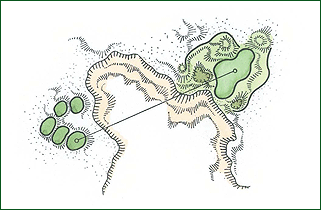
A golf shot that presents no alternative route to avoid a hazard or feature is said to be penal. The word comes from the Latin poena, which means “fine” or “penalty.” Penal golf deign is thought to have been a standard of early golf course design, but perhaps this is not so. Only sometimes did hazards completely obscure the path to the hole. In fact, on many natural links courses and even early designed courses, holes defined as penal were played by way of alternate routes devised by golfers who refused to believe there was no way around the impediment. They devised their own routes to the hole and, in the process, invented what has become known as strategic and heroic design – or, in our vernacular; detour, lay-up, or heroic design.
Penal golf holes are not in favor in today’s world. The logistics of getting all golfers to the hole is of paramount importance. An obstacle that requires playing across is not as appealing as one where the golfer has choices. Nonetheless, a place remains for penal design, as it provides a change of pace during the golf round.
The most workable condition for penal designs is when the design will not unfairly penalize the higher-handicap golfer. The penal design is also an excellent choice where there is no choice —- that is, when a natural hazard presents itself such that routing must get across it and the opportunity of drama cannot be ignored. A gorge 150 feet across is a good example. The hole might just lead to the shot of a lifetime and, for most golfers, a carry of this length is a doable feat. Penal design requires careful planning, though. It should only be administered in small doses and when appropriate.
The classic example of a penal shot is the very short par 3 where a range of tees can create a forced carry over water, wasteland, or sand. The actual carry is perhaps no more than 50 or 60 yards for the golfer who plays from the forward tees. It is presumed that nearly all golfers can negotiate a 60-yard carry. This is significantly more palatable than the same forced carry designed short of the green on a par 4. In this instance, the higher-handicap golfer may attempt a long iron or fairway wood to reach the green by virtue of his position off the tee. To necessitate a penal approach in this instance is reason for criticism of the penal school of design.
Heroic Design
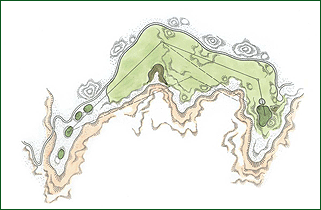
Heroic shots are those that must carry over an obstacle in order to gain a favorable position but where there is ample room to hit around the obstacle. Golfers can incrementally adjust the shot to aim either more over the obstacle or more away from it, depending on the level of excitement desired. A hero is the guy who clears the hazard or obstacle in the greatest dimension. The classic example of heroic design is the shot over a diagonal hazard that extends into the golf hole. The expression “bite off as much as you can chew” is often associated with heroically designed holes and shots. Again: All holes and shots are strategic.
Detour Design
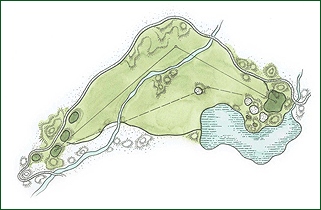
Detour shots, unlike heroic shots, offer distinct pathways around obstacles. The choice is to deal with the obstacle or hazard or not. This is not to say that heroic and detour design principles cannot be blended; in many instances, they are. If, for example, a lake presents a heroic opportunity, there may also be a wide and slightly longer fairway route to the hole along which the lake is taken almost completely out of play. In this case, the golfer faces shot options that are both heroic and detour in nature. And, for the mathematicians, you have just added to the 280 variables noted earlier.
Detour shots are shots around. Split fairways and isolated hazards sitting almost in the middle ground of a hole create detour options from which the golfer must choose — and the more the merrier. In golf, detours are good. They prompt thinking and problem solving. They bring out the best in golfers without requiring reliance on length. A drawback, however, is that detour shots often require extra width. Two routes – two fairways – take up more room than just one.
Lay-up Design
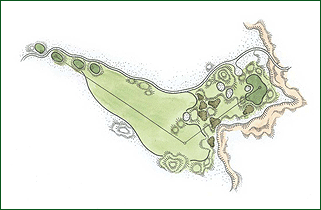
It can be said that a lay-up shot is up to the golfer and may be invoked at any moment in the round, even on penal, heroic, and detour shots. This is true. The hallmark of the true lay-up is force. The design condition that forces a shot to be played well short of a full shot cannot be considered either heroic or a detour. The lay-up shot is not always liked or appreciated, but it is nonetheless a part of the game. It can be brought about by playing conditions or through the use of a particular set of tees. That extremely penal lake fronting the green can require a lay-up shot when the wind is howling and the tees are back, but this is only a temporary condition. The lake fronting the green is meant to be carried and is therefore penal in nature on any other day.
The reason that lay-up design is not well liked is because it takes the element of gamble out of the golfer’s arsenal. If a shot is forced to be hit short, there is no real decision, only restraint. Aside from the possibility of a heroic shot by a skilled golfer to clear the obstacle that has caused the lay-up condition, the element of option is all but eliminated.
A lay-up design is probably best deployed on shortish par 4s at the tee shot. This interruption of brute force, when used sparingly, can be an interesting diversion. The best of all worlds is the lay-up shot that involves a degree of heroic and/or detour playing. Lay-up design, in these cases, brings even more decision making into the picture. Obviously, it has little use at par-3 holes, but great examples of par 3s where a lay-up area has been provided do exist. Merely having a lay-up area, however, does not necessarily constitute lay-up design. The lay-up area is provided as an option, not as a primary landing point. The most famous example of a par 3 embracing this design is the 16th at Cypress Point Club, a MacKenzie masterpiece. In reality the 16th at Cypress is heroic, detour and lay-up all wrapped into one.
Open Design
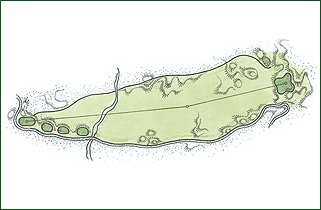
Open design is typically boring, with nothing-to-it fairways that are not encumbered by hazards, twists, obstacles, or anything else. The object is just to get there. That such shots and holes exist in golf is no reason to design more of them. To create abundant shot requirements that are completely open in their design is to go against the origins of golf and its point. Open design strategy should be reserved for appropriate points in a routing. Examples include leading up to a particularly difficult penal shot on a hole or for starting holes of a round. Even then, there should always be some obstacle and choice.
